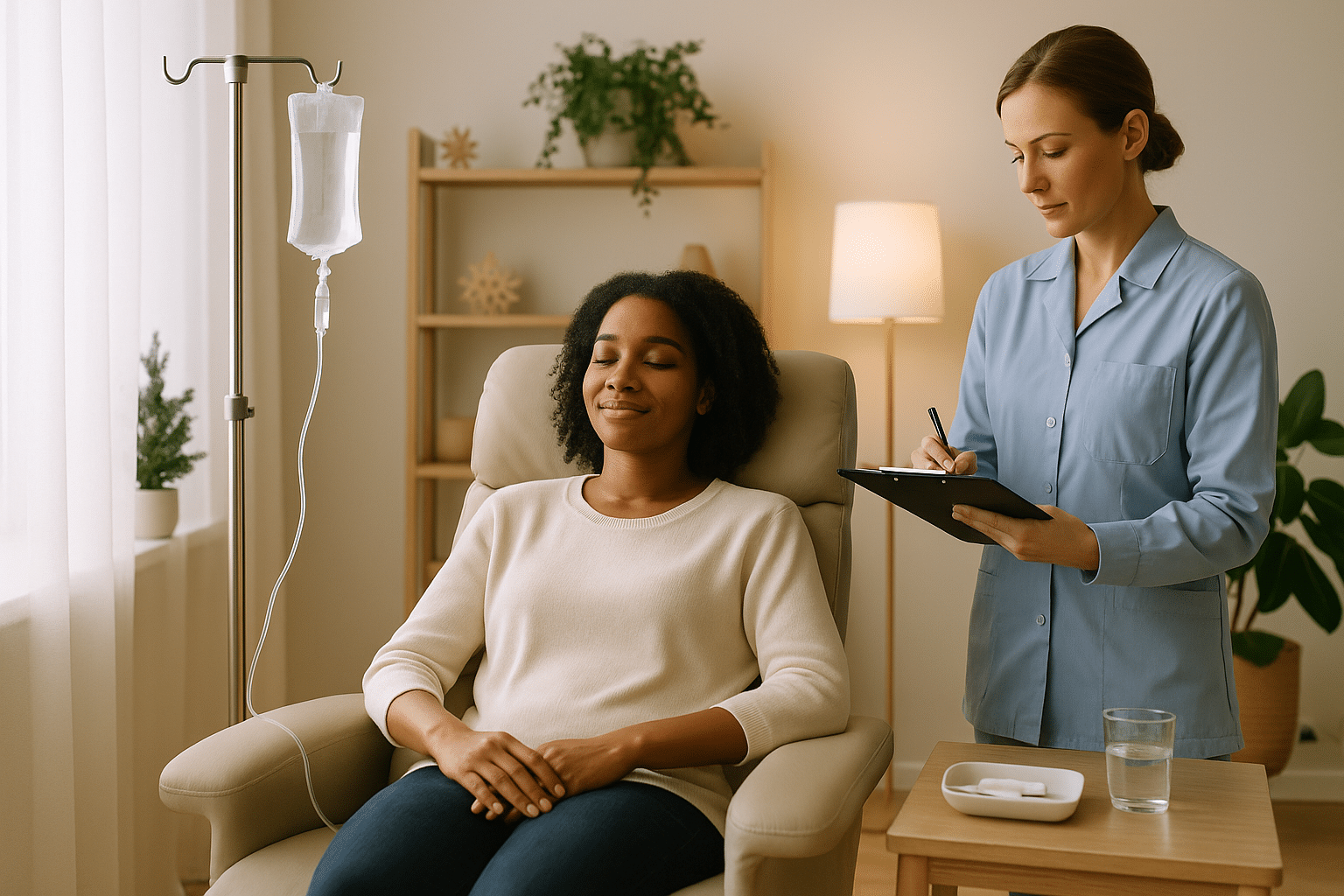Ketamine has become a buzzword in articles, podcasts, and even casual conversations about mental health. However, that quick rise makes some people suspicious. Is it just another wellness fad, like juice cleanses or miracle supplements, or does it hold up under scrutiny?
It helps to remember that ketamine isn’t new. Doctors have used it safely for decades as an anesthetic. Only in the last 15 years has research really focused on how it affects mood, depression, and suicidal thinking.
Although the attention feels sudden, the science has been building. The bigger question is how much of this is grounded in data and how much is simply cultural hype.
What Ketamine Actually Is (and Why It’s Different)
Unlike the antidepressants people usually know, ketamine doesn’t work on serotonin or norepinephrine. Instead, it blocks NMDA receptors in the brain. Blocking these receptors triggers other pathways that encourage new brain connections. Researchers think that’s why patients sometimes feel relief within hours, not weeks.
In 2019, the FDA approved esketamine (marketed as Spravato) for treatment-resistant depression. Later, approval expanded to adults struggling with major depressive disorder and suicidal thoughts.
The decision came after multiple trials showed not only quick improvement but also reduced relapse risk when patients stayed on treatment. One JAMA Psychiatry study found patients who combined esketamine with an oral antidepressant had fewer relapses over nearly two years.
Not every study has been positive. Out of three Phase 3 trials, only one showed clear benefits at 28 days, while the other two missed their main goals. Still, in psychiatry, especially with treatment-resistant depression, mixed results are common. Taken together, the evidence leaned toward benefit, which is why esketamine is restricted to certified clinics with patients monitored for at least two hours after dosing.
Contrast that with compounded or at-home ketamine lozenges. Those are not FDA-approved. The FDA issued warnings in 2023 after reports of serious side effects, including a case of life-threatening respiratory depression. This difference in approved nasal spray with strict safeguards versus loosely regulated take-home versions matters a lot when we talk about what makes ketamine clinically legitimate.
Safety Profile: Risks, Side Effects, and Misuse Concerns
Safety questions drive a lot of the skepticism. The common short-term effects are predictable: dizziness, blood pressure spikes, nausea, and dissociation. In esketamine studies, about a quarter (23–27.6%) of patients experienced dissociation. The dissociation typically peaked at 40 minutes and faded within one or two hours. With repeated dosing, it became less disruptive.
Long-term risks get more complicated. Recreational ketamine abuse has been linked to bladder damage and cognitive decline, but that’s in people using high doses over long periods without medical supervision. In clinical studies, patients monitored over months did not show the same severe urinary or memory problems. Some even showed stable or slightly improved cognition.
Still, ketamine is a Schedule III drug, which means the abuse potential is real. That’s why most clinics require an escort home and limit dosing to the minimum necessary. And it’s why the FDA insists on in-clinic observation for Spravato.
Why Therapy Pairings Matter
Ketamine often lifts symptoms fast, but those gains can fade in a week if nothing else changes. The dissociation that some people find disorienting can also make them more open to reflection. When guided properly, therapy becomes a chance to explore thoughts, emotions, and patterns in a way that sticks.
That’s the heart of ketamine-assisted psychotherapy. Instead of seeing ketamine as the entire treatment, it’s the starting point. Sessions afterward help patients integrate what they experienced and turn it into concrete change. Studies suggest outcomes are stronger and last longer when therapy is part of the plan.
A newer application showing up in clinics is ketamine couple therapy. The focus is more practical: using the treatment window, when emotions may feel more open, to explore relationship patterns. A clinician helps guide that process.
Some couples talk through old arguments in a calmer way. Other couples use the experience to slowly rebuild trust after hard times. Early clinical reports suggest there may be value, not only for a person’s own healing but also for the strength of the relationship.
For someone seeking ketamine therapy for depression, the principle is similar. The infusion or nasal spray can bring relief quickly, but without therapy, the effect may fade. Structured sessions afterward give patients space to process what came up and turn it into longer-term growth. That is how short-term changes become something that lasts.
What Makes Ketamine Clinically Legit (Not Just a Trend)
So, what separates legitimate treatment from passing craze?
Right now, the U.S. has between 500 and 750 ketamine clinics, many charging $600 to $1,000 per infusion. Industry revenue hit $3.1 billion in 2022 and could double by 2030.
Those numbers feed the perception of a money-driven trend. Critics sometimes describe the landscape as the “Wild West,” and in some cases, that’s not far off. Protocols vary widely, and not every clinic follows best practices.
However, in structured programs, legitimacy is clear. Standard IV dosing is 0.5 mg/kg over about 40 minutes. Vitals are monitored throughout. Aftercare involves integration therapy, not just a quick discharge. Insurance companies are also beginning to recognize the difference, covering FDA-approved esketamine treatments while refusing coverage for compounded take-home products.
Compared to traditional antidepressants, ketamine fills a gap. SSRIs can take six weeks or more to work, and many patients never respond. Ketamine’s ability to reduce symptoms and even suicidal thinking within hours addresses needs that existing drugs cannot.
Zeam’s Perspective: Empathy + Evidence in Practice
At Zeam Health & Wellness, we know patients come in with doubts. Some worry they are chasing a fad. Our approach is to separate what’s trendy from what’s supported. That means careful psychiatric evaluation, safe delivery in certified settings, and integration therapy to extend results.
For many patients considering ketamine therapy for depression, the real value comes from balancing the fast relief it can bring with strategies that support recovery over time. We also provide ketamine couple therapy, giving partners a way to work on healing together in a guided, safe space.
If you are unsure but curious, we encourage you to reach out. Zeam Health & Wellness serves Sacramento, Folsom, and Roseville with evidence-based psychiatric treatment that puts care before hype.
Key Takeaways
- Ketamine is not new — it has been used safely for decades as an anesthetic before research expanded into depression and mood disorders. [1]
- Unlike SSRIs, ketamine blocks NMDA receptors, triggering brain pathways that support new neural connections and fast symptom relief. [2]
- In 2019 the FDA approved esketamine (Spravato) for treatment-resistant depression and later for suicidal thoughts, following multiple clinical trials. [3]
- Not all studies are positive — only one of three Phase 3 trials showed clear benefits at 28 days, but overall evidence favored clinical use with safeguards. [3]
- At-home ketamine lozenges are not FDA-approved and have been linked to safety risks, prompting FDA warnings in 2023. [4]
- In trials, about 23–27.6% of patients experienced dissociation, peaking at 40 minutes and fading within two hours. Side effects often decline with repeated dosing. [3]
- Long-term risks like bladder damage or cognitive decline are linked to recreational abuse, not supervised clinical use. Studies show stable cognition in monitored patients. [5]
- Ketamine works best with therapy — integration or ketamine-assisted psychotherapy extends benefits, while infusion alone may fade within a week. [6]
- Couples therapy applications are emerging, showing promise in rebuilding trust and communication during ketamine’s “therapeutic window.” [7]
- The ketamine industry topped $3.1 billion in 2022 and could double by 2030. Critics call it a “Wild West,” but structured, FDA-approved programs with therapy remain clinically legitimate. [8]
References
[1] Domino EF. Taming the Ketamine Tiger. Anesthesiology, 2010.
[2] Zanos P, Gould TD. Mechanisms of ketamine action as an antidepressant. Molecular Psychiatry, 2018.
[3] Daly EJ et al. Efficacy and Safety of Esketamine Nasal Spray Plus Oral Antidepressant for Treatment-Resistant Depression: Results of a Long-Term Study. JAMA Psychiatry, 2019.
[4] FDA. FDA Warns About Risks of Compounded Ketamine Products, Including Lozenges. U.S. Food & Drug Administration, 2023.
[5] Morgan CJA, Curran HV. Ketamine use: a review of clinical effects and abuse liability. Addiction, 2012.
[6] Dore J et al. Ketamine Assisted Psychotherapy (KAP): Patient Outcomes and Satisfaction After One Year. Journal of Psychoactive Drugs, 2019.
[7] Early reports on ketamine-assisted couples therapy (clinical observations, not yet large RCTs).
[8] Global Market Insights. Ketamine Clinics Market Size Report, 2022–2030.




